Garden Glimpses: Hydrangea Haven
[Alice and Annabelle hydrangeas relax in the shade, with a less-than-usually-troublesome squirrel standing guard]
Or is that “heaven”? It’s been awhile coming, but now, in their third summer here, the hydrangeas are really beginning to come into their own. I have five varieties, four Oakleaf and one arborescens, and all are showing improvement over last year’s output.

Progress has been uneven, however. Oakleaf varieties Snowflake and Pee Wee have been consistently adding to their height and girth; in time, Snowflake will form a massive shrub 6-10 feet tall and about as wide. Planted in the dappled light of my birch tree, this may restrict its ultimate size, but as it is intended as a secondary screen for the shade garden, so long as it reaches the level of the lowest birch branches, I’m good with that. And this it has already accomplished, if barely and not yet broadly. It has markedly more blossoms than last year, but the shade level might be inhibiting full flowering. Its blooms are huge – some more than a foot in length.

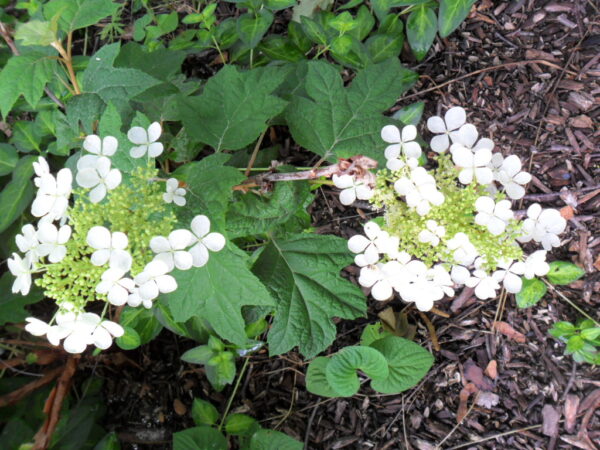
Pee Wee, as the name implies, is a dwarf variety, growing just 3-4 feet in height and with a similar diameter. Also under the birch, it’s reached its maximum height in spots, and I’ve even had to trim back the birch a bit so they don’t entangle, but it still has some growing to do widthwise. Its floral output, however, has massively increased, with some two dozen blooms this year, compared to last year’s showing of about a dozen.
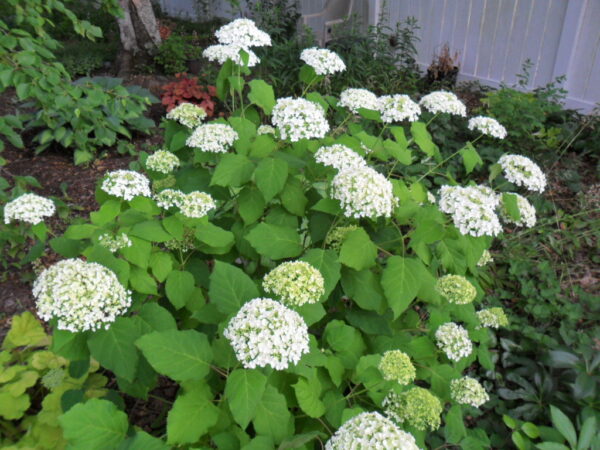
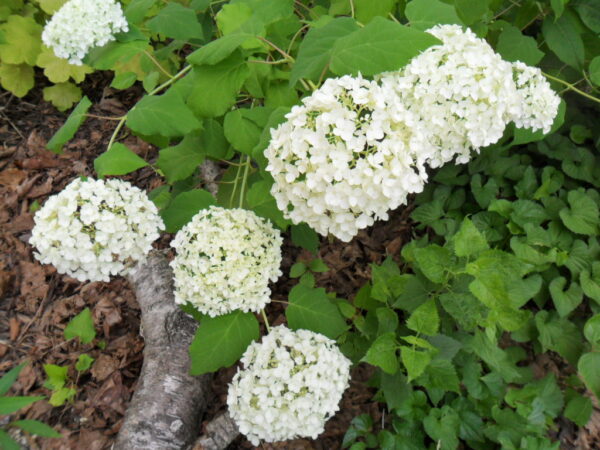
Annabelle is my only arborescens, placed strategically at the edge of the maple canopy shade, so it gets good light in the afternoons. I’ve been rewarded for this thoughtfulness with a truly stunning show this year of more than three dozen blooms. These are in a traditional hydrangea “snowball” shape (as opposed to the more elongated form of most Oakleafs), very festive and brilliantly white once fully opened. My only complaint is that Annabelle isn’t the strongest girl on the block, and in the sorts of torrential rains we’ve had of late, she flops her pretty tops onto the ground. She raises her heads again after the deluge, but so far, not quite so high as formerly.
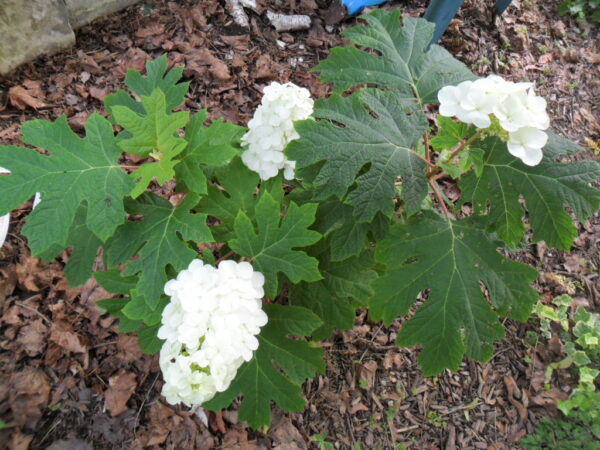
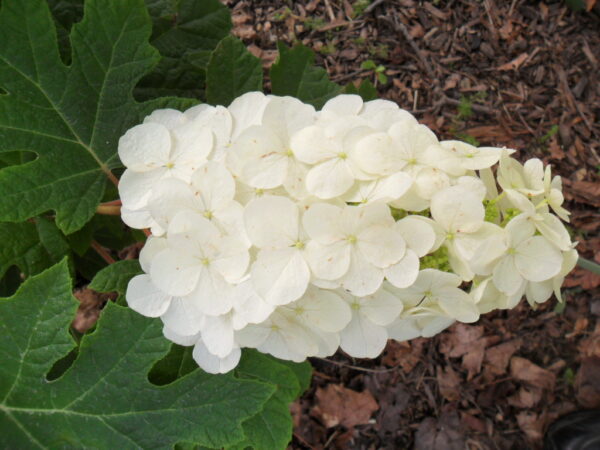
Queen of Hearts is at a double disadvantage in size; a year younger than her sisters, she also suffered a catastrophic loss her first winter here, with some unspecified disaster robbing her of half her branches, broken clean off. What caused this remains a mystery, but Queen of Hearts has been busy trying to make up the deficit, and is looking balanced and symmetrical once more. Last year she gave but one bloom, this year she has three, still a small shrub in relative infancy. I’m beginning to wonder if she was also mislabeled by the grower – as her name suggests, her flowers should turn a pale rosy pink at some point, but they remained pristine white all last season until browning in the fall. We’ll see what happens this year. Regardless, it’s a lovely blossom, composed of brilliant white florets so closely packed as to provide no space between them, creating an almost “shield” effect, whereas most hydrangea blossoms are more aerial in design, with smaller mini-blossoms punctuating the larger sprays.

But I’m most proud of Alice, another Oakleaf which, up to now, has given me just one stunted bloom. She’s a quick grower, however, rapidly moving toward her 8’x8’ ultimate dimension, and her fall color is unbeatable – a superb range of rust-red and burgundy, eye-catching in the extreme. Given this, I might not have minded at all if she remained flowerless, but Alice really came through in that department this year, with nearly a dozen lovely blossoms, almost as large as Snowflake’s.

Hydrangeas make excellent cut flowers for bouquets, long-lasting and dramatic accents for the dining table or living room. They also dry beautifully, for year-round interest. Unfortunately, every bit of hydrangea is toxic when ingested by cats, but since the passing of my beloved Ashes this spring, that moratorium has been lifted (trust me, one of the very few perks of the situation), and with this year’s bumper crop of blooms, I’ve been indulging myself with lush bouquets of Annabelle, Alice and Snowflake.

Of course there’s more going on in June than just hydrangeas. Principally, this month is the peak for butterfly weed and Asiatic lily varieties, as well as the emergence of heliopsis, Shasta daisy and coreopsis, and the heyday of thistles.
Yes, I said thistles. These notorious, virtually ineradicable weeds are actually great soil amenders, breaking up my dense clay soil with their deep taproots, so I always allow several stands of these to thrive, varying the locations year to year, knowing that whatever I plant there next stands a much better chance of survival for their unwitting ministrations. As well, I do enjoy their lovely medium-purple blooms, pollinators love them, and once they have finished blooming and mature to their fluffy thistledown stage, they are a magnet for goldfinches and other birds, who feast on the seeds.
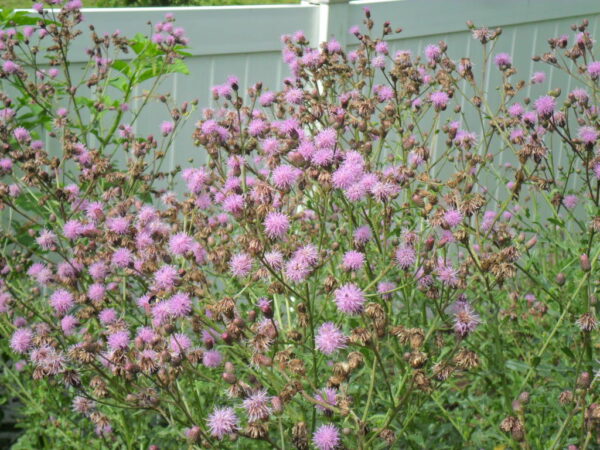
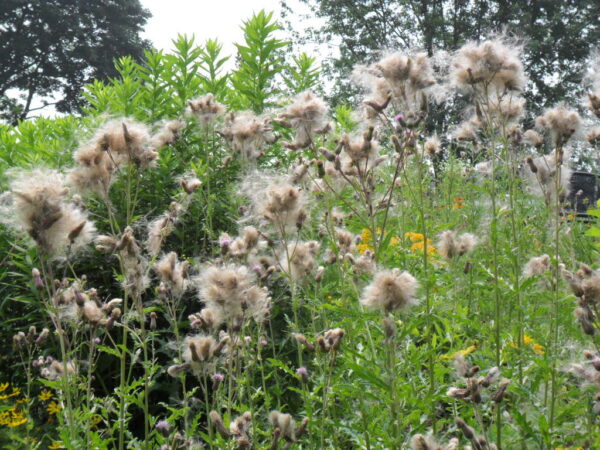
St John’s Wort is another wildflower that lends a special grace to the garden in June; so-named for its habit of blooming on or about St John the Baptist’s Day, June 24, this plant is an import from European settlers that as a garden escapee has now ranged far and wide in North America. A popular medicinal and magical herb since medieval times, St John’s Wort would be hung on house and stall doors to ward off evil spirits and to safeguard against harm and sickness to people and live-stock. Its clusters of diminutive deep amber-gold flowers brighten any corner of the garden where they appear, glowing like the solstice sun come to play.
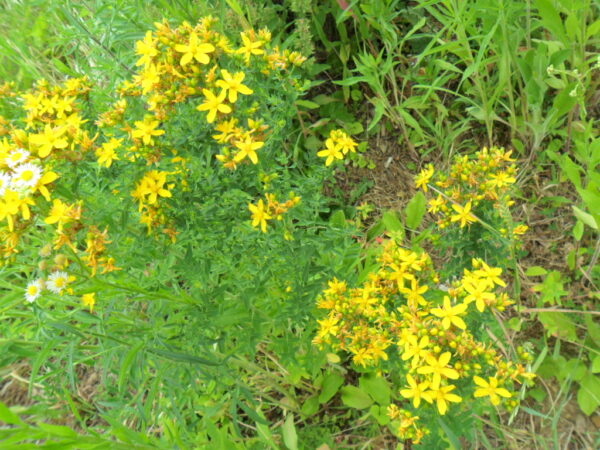
Asiatics and daylilies perform very differently, but both have qualities to commend them. In general, daylily bloom might be more prolific, and they certainly have a longer bloom season overall, but their individual blossoms last but a day, as their name foretells. Asiatics, on the other hand, tend to less voluminous bloom, with fewer stalks per bulb, but more blooms per stalk, and the individual flowers can last days, even a full week, depending on conditions.
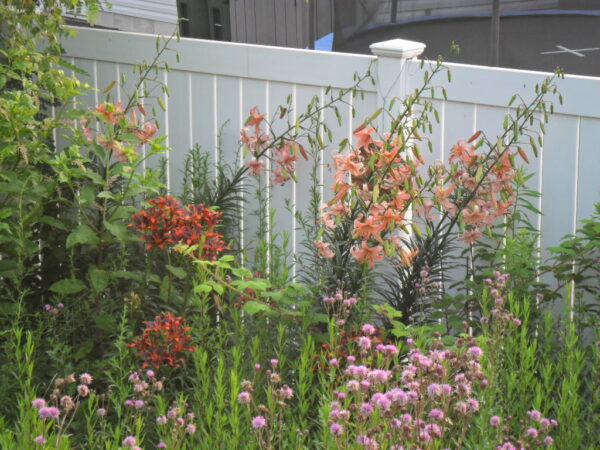
Their longer-lived blooms means Asiatics are also more amenable to cutting for bouquets. There are two ways to do this. As the bloom head matures and nears the end of its cycle, one can behead the plant and bring the entire top inside, first removing any spent blossoms lower down. You can be confident that any unopened buds will unfurl in time (unlike daylilies, which may not fully bloom out if the side buds are very immature when cut). Alternately, if you don’t want to wait, or sacrifice the entire bloom head to an indoor bouquet, you can nip off individual flowers for use in short bud vases. Even a single blossom makes a bold showing as an accent in a bathroom or guest bedroom, or a living room end table.

I have five varieties of Asiatic lily: Forever Susan, a gorgeous orange and purple/black stunner that blooms first (and which I have dubbed “Halloween lily” from its coloring); Pink Giant, a very apt descriptor of this 8-foot-plus-tall behemoth, with medium pink petals flecked with burgundy-brown spots; African Queen, a golden yellow trumpet-shaped lily with a purple-brown blush on the reverse of the petals; Stargazer, the ubiquitous pink-and-white variety so common in foundation and border plantings; and Tiger, an heirloom from my parents in orange spotted with chestnut brown, which blooms latest, typically in early August.

Last year’s drought seems to have been a death sentence for most of the Tiger lily patch, but there are seedlings sprouting up across the garden, and I have hopes that in time, these will fill in and return this lovely color to the landscape. The other varieties are thriving, however, and as June bleeds into July, Forever Susan is just past peak, with Pink Lady almost there, and the rest showing good bud development. The daylilies are just getting started; July is their heyday, and with more than forty varieties on the property, it’s a sight to see.
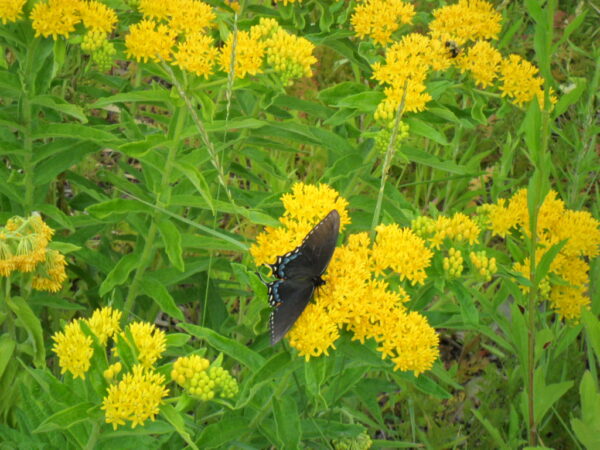
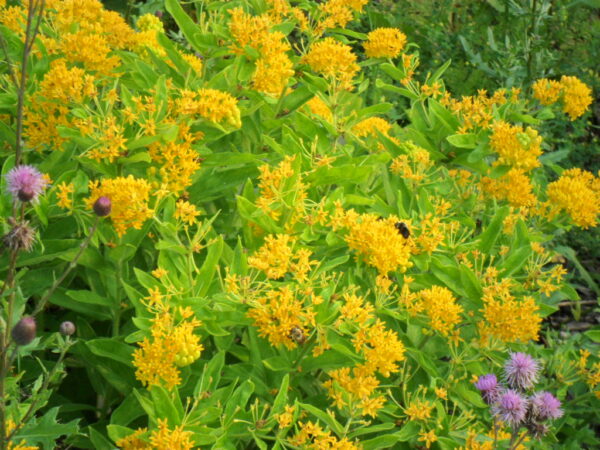
The yellow butterfly weed, Asclepias tuberosa, is one of the few mail-order successes I’ve had. Planted as bareroot stock in the spring of 2020, that first season wasn’t promising at all, and I doubted if they’d make it (indeed, another variety I bought at the same time, in purple and white, never did sprout). But they returned the following year, still very weedy-looking and with small bloom heads. Last year the show was markedly better, and this year, they are masses of golden rafts of bloom, on thick, sturdy stems. It’s rare that I pass them by without noting at least one or two species of bee or butterfly sipping at their blossoms, and they flower for several weeks before fading. Ironically, a plant of the more traditional orange-flowered staple, which I purchased potted at a local nursery, hasn’t done as well, and seems to lose a bit of ground each year, a total reversal of my usual pattern, where local finds outperform mail-order.
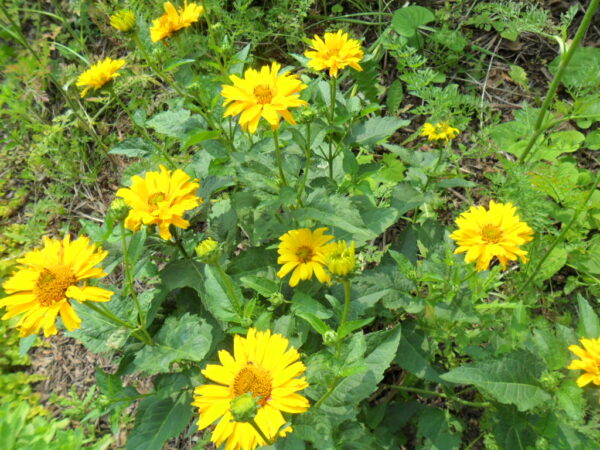
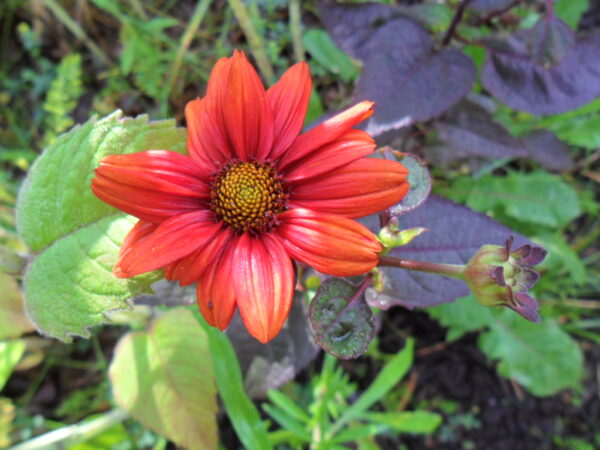
June is also the starting gun for a wide array of daisy and daisy-like flowers, from heliopsis to Shasta daisy, rudbeckia and echinacea, and coreopsis. I have four stands of the common heliopsis, one of my favorites, with striking rich gold multi-layered flowers sporting fuzzy round centers. These appear to have taken a step back this season, perhaps another casualty of the 2022 drought, but are still quite lovely, and I expect they’ll expand again if conditions are right. I have a second variety, Bleeding Hearts, which has purple-brown foliage and blooms in a more orange-rust tone, fading to yellow-sepia. These are not as vigorous as the standard variety, but are holding their own year to year, a welcome contrast to the profusion of yellow in the summer garden.
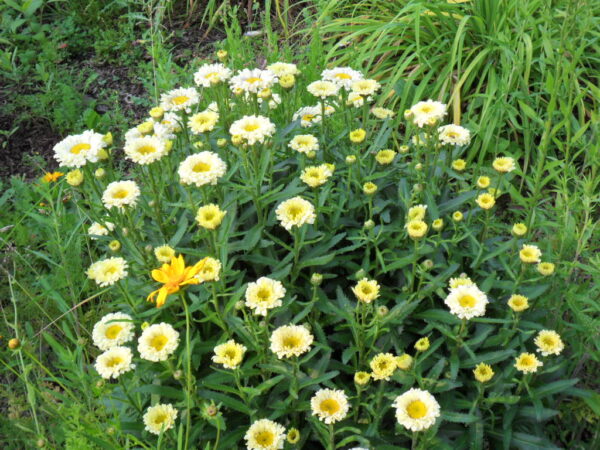
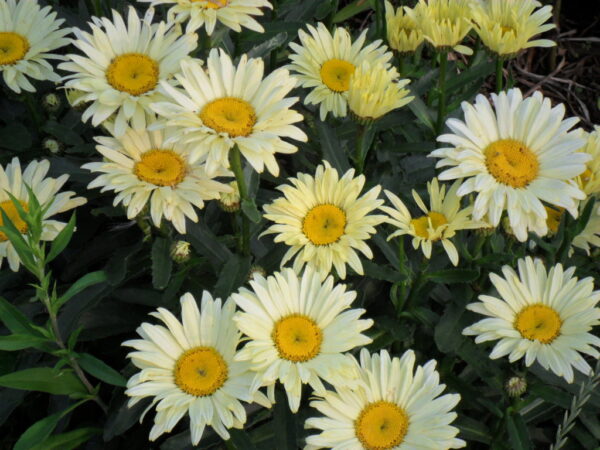
The Shasta daisies are also coming into peak in June, with broad creamy-white flower heads dotted with bright yellow centers. Although I purchased mine at the same garden center, sitting side by side, both marked the same, they are distinctly different from each other, with one having a slightly paler bloom and petals that are rounded at their tips, and the other sporting pointed petals. Their foliage and growing habit is identical, and they bloom simultaneously, and while I’m not at all adverse to variety in the garden, it’s just mystifying how such a thing occurs.
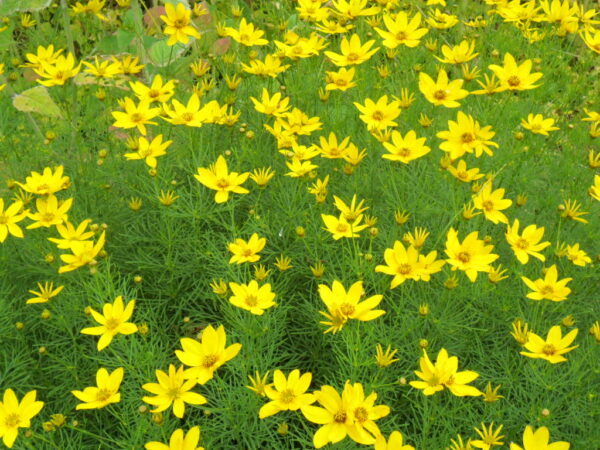

Coreopsis has a leg up at this time as well. The self-sown wild native, inexpressibly bright and cheery in bold yellow, has been blooming since May, and after allowing the first plant to thrive four years ago, I now find it popping up all over the garden, a welcome addition wherever it emerges. Cultivars on my plant list include Moonbeam, a pale-yellow version that never does all that well for me, and Zagreb, a saffron-yellow stunner that has become a massive mound over the years. I’ve tried Rosea, a pretty pale pink bloomer, several times, but can never get it to return, and I just purchased two plants of “Sassy Saffron,” with a yellow blossom banded in burgundy. They’re heavily budded, but not yet open, and very vigorous, so I’m hoping they’ll become well established for years of bloom to come. Also known as threadleaf or tickseed, coreopsis comes in a wide range of fire tone colors, to please any gardener’s palette, and is drought-tolerant, something becoming more and more advisable as climate change alters precipitation patterns in my region.
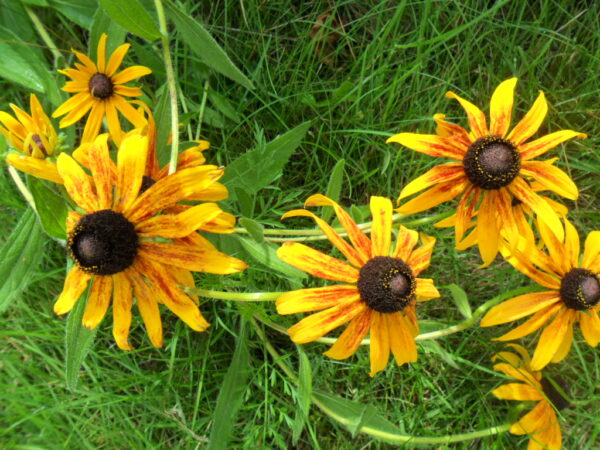
Rudbeckia, or Brown-Eyed Susan, comes in several forms, both perennial and self-sowing annuals. Every year it’s a mixed bag from the latter as to what comes up where. After several years of increase, 2023 shows a marked dropping off of viable seed from 2022, perhaps attributable once again to the drought. It may be that some plants dried up before setting seed, or the seeds they did drop were adversely affected by lack of moisture. I’ll miss the wide range of colors these provided, from standard yellow, not unlike the perennial variety, to those tinged, banded or striped with orange, red and even brown, due to cross-pollination which creates new styles year to year. Some of the few annuals to germinate are just beginning to pop, but the perennials, of which I have over half a dozen well-established plantings, are weeks away yet from bloom.
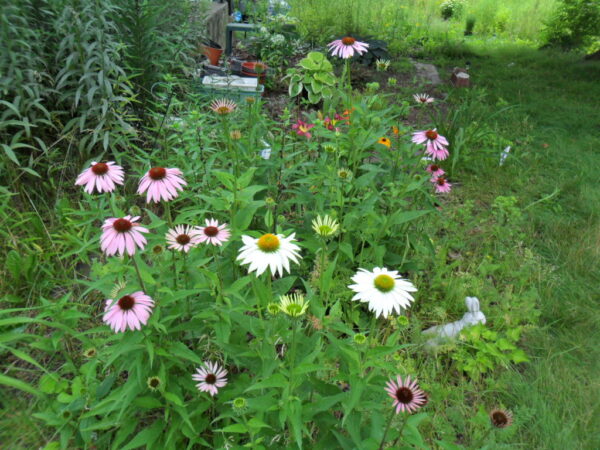
Likewise the echinacea, just now starting to unfurl. I have mainly pink and white specimens of this native, commonly known as coneflower, but the species varieties always do best for me. Some of the more hybridized cultivars, popular of late in garden centers, are not true perennials, or at least, don’t return as reliably as those they were developed from. They come in attractive shades of yellow, orange, burgundy and a showy multicolored “sunset-like” variety called “Cheyenne Spirit,” which I’ve had some success at maintaining, though it dwindles year to year and has never had the vigor of its initial season. But if you want to grow these, it’s best to think of them as annuals, and here at the Miller Estate, we don’t use the “a” word. Echinacea is another plant that keeps on giving: drought tolerant, colorful, a pollinator magnet, birds enjoy the seeds in the dried cone head and the plant lends visual interest even in the dead of winter.

As June rolls over into July, anticipation is high for the daylily festival, as I like to call it. And then the reign of the natives begins, as late summer and autumn brings on bloom from goldenrods and white snakeroot to asters. But for now, time to grab an iced tea and relax in the shade of the birch with my lovely hydrangeas swaying in the breeze.


3 comments, add yours.
Sandi
How beautiful! I planted a new hydrangea this year (found on half-price table at Lowes) and had to plant it FOUR times. Something kept digging it up. I put a cage around it, wrapped chicken wire around THAT, and still it got dug up. Now it’s in a hanging pot temporarily, till I can find a permanent spot (and solution!)
Irmgard Dering
Always looking forward to your flower show! Hydrangeas are among my favorites…
Thank you!
Laurien
I really enjoyed the gorgeous photos, Alex, especially of the hydrangeas and lilies, two of my favourites. But I also loved learning about how useful the thistles are and the history and lore of St. John’s Wort. Glad the butterflies, bees, and goldfinches are supported by your garden. Nature needs all the help it can get these days. Thanks, Alex, and enjoy the summer!